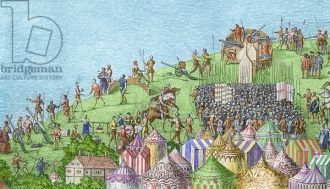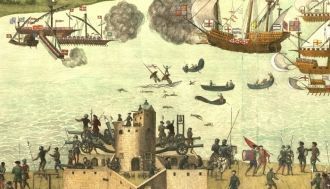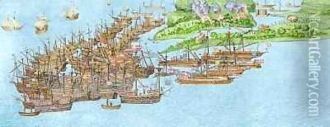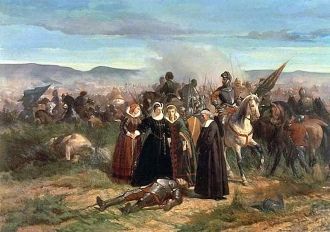Great Britain
Arrived off the Isle of Wight on July 18th, D'Annebaut sent Polain with four galleys to reconnoitre the situation of the English fleet which still lay within, and which had for the time completely surrendered the command of the sea. Fourteen English vessels weighed with a very light land wind, and stood out of harbour as if to cut off the galleys, which fell back upon the advancing body of the French. Thereupon, the rest of the English ships weighed and went slowly out; and an interchange of shot at long range ensued, no particular damage however being done on either side. The English manoeuvred to draw the enemy among the shallows on the Spit Sand and under the guns of the defences of the town; but D'Annebaut was too wary to be thus caught, and, as night came on, retired to St. Helen's Road, where he found that his largest ship, the Maitresse, was making so much water that he had to send her back to Le Havre to be docked.
During the night D'Annebaut rearranged his order of battle, dividing his larger ships into three squadrons, with himself in command of thirty vessels in the centre; De Boutieres with thirty-six vessels on the right, and Baron de Curton with thirty-six vess els on the left. The galleys under Polain were ordered to approach the English in the morning, and attempt to induce them, by firing at them, to follow the French to sea. But it would seem that these orders were not carried out very early.
On the 19th, King Henry was with Lord Lisle in the Henry Grace a Dieu when the first movement of the enemy was noticed, and he at once ordered an attack and went ashore. In moving out the Mary Rose, of 500 tons, being very low in the water, heeled so much when her helm was put hard over, that the sills of her open lower ports, only 16 inches out of the water ere she heeled at all, were submerged. She rapidly filled and sank, carrying down with her her captain, Sir George Carew, and all hands, except about thirty-five persons. This awful catastrophe was witnessed from the shore, not only by the king, but also by Lady Carew, the wife of the gallant and unhappy commander.
French historians are almost unanimous in asserting that the Mary Rose was sunk in action, some, as Du Bellay, attributing the result to gun-shot, and others, as Guerin and other modern writers, claiming the ship as the victim of the galleys of Polain. There is not a shadow of doubt that she perished as has been related, before she had an opportunity of getting into action.
The wind was too light to enable the English ships to manoeuvre properly; and, as the French galleys did not depend upon wind, they were able to inflict a certain amount of annoyance, especially upon the Henry Grace d Dieu. But the armed boats of the fleet and the row-barges made a good fight with the enemy until, late in the day, the wind freshened. The galleys were then driven off, and, had not D'Annebaut moved to their assistance, would have suffered heavily. No serious effort, however, was made to engage the main force of the French; and once more the English spent a night among the shoals.
On July 20th, the French landed men at three separate places in the Isle of Wight and plundered some villages, but were easily driven off. Soon afterwards the whole fleet withdrew, coasting as f ar as Dover, landing at Brighton and Newhaven, but being repulsed there; and then crossing to Boulogne, near which place D'Annebaut put ashore four thousand soldiers and three thousand workmen to assist in the long-deferred siege.
Source: http://threedecks.org/index.php?display_type=show_battle&id=376



 United Kingdom,
United Kingdom, 










